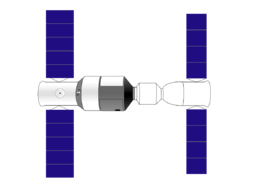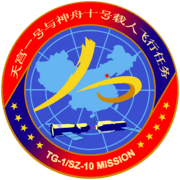Shenzhou 10
Shenzhou 10 (Chinese: 神舟十号; pinyin: Shénzhōu Shíhào) was a crewed spaceflight of China's Shenzhou program that was launched on 11 June 2013. It was China's fifth crewed space mission.[2][3] The mission had a crew of three astronauts: Nie Haisheng, who was mission commander and previously flew on Shenzhou 6; Zhang Xiaoguang, a former PLAAF squadron commander who conducted the rendezvous and docking; and Wang Yaping, the second Chinese female astronaut. The Shenzhou spacecraft docked with the Tiangong-1 trial space laboratory module on 13 June,[4] and the astronauts performed physical, technological, and scientific experiments while on board. Shenzhou 10 was the final mission to Tiangong 1 in this portion of the Tiangong program.[5] On 26 June 2013, after a series of successful docking tests, Shenzhou 10 returned to Earth.[6]
 Diagram of Shenzhou-10 (right) docked with Tiangong-1 (left) | |
| COSPAR ID | 2013-029A |
|---|---|
| SATCAT no. | 39179 |
| Mission duration | 14 days, 14 hours, 29 minutes |
| Spacecraft properties | |
| Spacecraft type | Shenzhou |
| Manufacturer | CASC |
| Crew | |
| Crew size | 3 |
| Members | Nie Haisheng Zhang Xiaoguang Wang Yaping |
| Start of mission | |
| Launch date | 11 June 2013, 09:38:02 UTC |
| Rocket | Long March 2F |
| Launch site | Jiuquan LA-4/SLS |
| End of mission | |
| Landing date | 26 June 2013, 00:07 UTC |
| Landing site | Inner Mongolia |
| Orbital parameters | |
| Reference system | Geocentric |
| Regime | Low Earth |
| Perigee altitude | 262 kilometres (163 mi) |
| Apogee altitude | 315 kilometres (196 mi) |
| Inclination | 42.7 degrees |
| Period | 90.28 minutes |
| Epoch | 12 June 2013[1] |
| Docking with Tiangong 1 | |
| Docking date | 13 June 2013, 05:11 UTC |
| Undocking date | 25 June 2013 |
| Time docked | 12 days |
 Shenzhou programme | |
Preparations
Prior to the reboost of Tiangong 1 on 30 August 2012, it was projected that a launch window would open between late November and December 2012, when Tiangong-1's orbit had decayed to the level of a Shenzhou's standard orbit. With the reboost, it was expected that the orbital decay would bring Tiangong-1 within reach again in late January, so the Shenzhou 10 mission was anticipated for late January or February 2013.[7] At the 2012 Communist Party of China Leadership Congress, a space official stated that Shenzhou 10 was planned for the period between June and August 2013.[8]
It is the fifth crewed mission of the Shenzhou programme, coming ten years after the original, Shenzhou 5.[9]
From 2012 November onwards, a feed of information ensued, including a desire for the crew to have a female member and that the actual launch date would be at the beginning of the June–August period. Knowledge of the conditions that China sets for launch windows for its piloted spacecraft allowed the likely launch date to be calculated as somewhere in the period between 7–13 June.[10]
Xinhua published an item from the Beijing Times that summed up the aims of the mission, and included the information that Wang Yaping was the only female trainee in the group of astronaut candidates.[11] Wang Yaping was announced to be the one of the crew in April 2013, the only member of the crew revealed until June, when the rest of the crew was revealed. The crew of Shenzhou 10 previously served as the backup crew to Shenzhou 9.[12][13] With Nie Haisheng's elevation to General, this marked the first instance that China would launch a flag officer into space, after they had become a general officer.[14]
Launch and docking
Shenzhou 10 was launched on 11 June 2013, at 09:38 UTC (17:38 local time). A Long March 2F[15] carrier rocket was used to perform the launch, flying from Pad 1 of the South Launch Site at the Jiuquan Satellite Launch Centre in Inner Mongolia. The spacecraft successfully reached low Earth orbit before the rocket detached. With a duration of 15 days, Shenzhou 10 was China's longest human spaceflight mission to date,[16][17] surpassing the previous record holder, Shenzhou 9 by two days.[18] CPC General Secretary, Chinese President Xi Jinping was present for both the departure ceremony, and the launch itself.[19]
The spacecraft docked with Tiangong 1 at 05:11 UTC on 13 June. The crew opened the hatch three hours later and entered the laboratory module.[20].
Landing
Shenzhou 10 returned to Earth on Wednesday, June 26, 2013 00:07 UTC. Total mission duration was 14 days 14 hours and 29 minutes.[21]
Objectives
Once docked at Tiangong 1, the three crew members conducted space medicine and technological experiments and other scientific endeavours. Nie Haisheng was mission commander, overseeing docking procedures, and pilot Zhang Xiaoguang was in charge of rendezvous and docking. Wang Yaping conducted the scientific experiments and taught a physics lesson to Chinese students by live television broadcast.[22] On 23 June Shenzhou 10 undocked from the station and performed a manual re-docking.[23]
Crew
| Position | Crew Member | |
|---|---|---|
| Commander | Nie Haisheng Second spaceflight | |
| Second crewmember | Zhang Xiaoguang First spaceflight | |
| Third crewmember | Wang Yaping First spaceflight | |
While in orbit, Wang Yaping was one of only two women in space on 16 June 2013, the 50th anniversary of Vostok 6, the first space flight by a woman, Valentina Tereshkova. The other woman in space that day was Karen Nyberg on board the International Space Station[24]
Space lecture
One widely reported event of this mission was the space lecture[25] by Wang Yaping. On 20 June around 10:00 two physics teachers started the lesson in the Beijing classroom. A few minutes later the crew was visible to 60 million Chinese students. They saw Wang Yaping conduct five experiments:
- Mass measurement: Using Newtons Second Law (F=m x a) the mass of Nie Haisheng was measured to be 74 kg.
- Simple pendulum: The Beijing class started by showing a simple pendulum, then Wang Yaping did the same to show the pendulum moving in an endless rotation.
- Behaviour of a Gyro: Wang Yaping put two Gyros up, one spinning and one not, and touched both slightly. The spinning gyro kept its axis.
- Surface Tension: Wang Yaping showed the importance of surface tension in the absence of gravity by wobbling a water film inside a ring. When swinging the water film bulged, but it did not break.
- Water ball: Wang Yaping showed that water will automatically form a (near perfect) ball in space and explained this using the same surface tension.
See also
- Chinese space program
- Jiuquan Satellite Launch Centre
- Long March 2F
- Tiangong program
References
- McDowell, Jonathan. "Satellite Catalog". Jonathan's Space Page. Retrieved 25 May 2014.
- (in Chinese) news.China.COM.cn, "专访十八大代表牛红光:神十将于明年6月发射", 新闻中心-中国网, 10 November 2012
- "Chinese spacecraft blasts off with 3 astronauts". 11 June 2013.
- Chinese spacecraft blasts off from Gobi desert The Guardian, 2013-06-11.
- "China prepares to launch first space lab module this week". Space Daily. 27 September 2011. Retrieved 28 September 2011.
- ITN (25 June 2013). "China's Shenzhou 10 spacecraft's docking manoeuvres a success - video". The Guardian.
- SpaceDaily, "Tiangong Orbit Change Signals Likely Date for Shenzhou 10", Robert Christy, 4 September 2012
- ScienceDaily, "China to launch new manned spaceship in 2013: Xinhua", Reuters, 10 November 2012 (accessed 2012-11-11)
- Bodeen, Christopher (10 June 2013). "China marks decade of human spaceflight". Associated Press.
- Christy, Robert (11 March 2013). "Shenzhou 10 – Heads Up!". zarya.info. Archived from the original on 16 June 2013.
- Xinhua (in Chinese), "Shenzhou 10 Arrived at Jiuquan for Launch June-August, Yaping is the Only Female Astronaut Candidate" Archived 4 April 2013 at the Wayback Machine, Beijing Times, 1 April 2013
- Jones, Morris (3 April 2013). "Shenzhou's Shadow Crew". Space Daily.
- "Astronauts of Shenzhou-10 mission meet press". Space Daily. 11 June 2013.
- "China's space dream crystallized with Shenzhou-10 launch". SpaceDaily. 16 June 2013.
- Barbosa, Rui C. (10 June 2013). "China launches three person crew on Shenzhou-10". NASASpaceflight.com. Retrieved 12 June 2013.
- Wong, Andy (11 June 2013). "Shenzhou 10 Launch: Chinese Spacecraft Blasts Off With Three Astronauts On 15-Day Mission". Huffington Post. Retrieved 11 June 2013.
- Tate, Karl (10 June 2013). "Shenzhou 10 Explained: Crew of Three Chinese Astronauts Head to Space Lab (Infographic)". Space.com. Retrieved 11 June 2013.
- "China's Shenzhou-9 spacecraft returns to Earth". BBC. 29 June 2012. Retrieved 11 June 2013.
- Deng, Shasha (11 June 2013). "Chinese President sees off Shenzhou-10 crew, watches spacecraft launch". Xinhua. Archived from the original on 16 June 2013.
- "Chinese capsule docks with space laboratory". BBC. 14 June 2013. Retrieved 14 June 2013.
- "China's Shenzhou-10 Crew Returns To Earth". Universe Today. June 2013. Retrieved 4 July 2017.
- Clark, Stephen (11 June 2013). "Successful start for China's fifth human spaceflight". Spaceflight Now. Retrieved 11 June 2013.
- http://www.china.org.cn/china/2013-06/23/content_29203515.htm
- Ken Kremer (16 June 2013). "Cosmonaut Valentina Tereshkova; 1st Woman in Space 50 Years Ago! Ready for Mars". Universe Today.
- http://www.go-taikonauts.com/en/chinese-space-news/668-published-9th-issue-of-newsletter-on-chinesea-space-activities-go-taikonauts
External links
| Wikimedia Commons has media related to Shenzhou-10. |
| Wikimedia Commons has media related to Tiangong 1. |
- Shenzhou 10 Launch Campaign
- Build-up to the Shenzhou 10 mission
- CBS News, Shenzhou 10 docking test - video, 25 June 2013
- The Guardian, China's Shenzhou 10 spacecraft returns to Earth - video, 25 June 2013
- Shenzhou Launch Windows
- "China Might Be Planning Early Space Station Attempt". SpaceDaily.com. 19 February 2006.